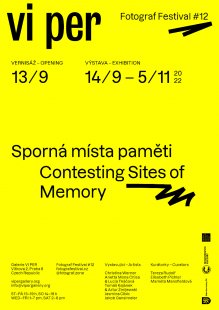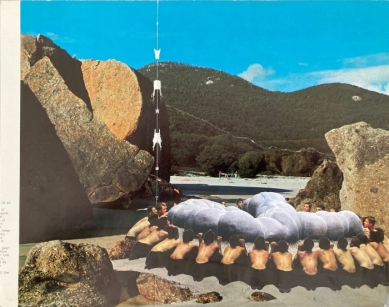
Contested Memory Places - Opening at Galerie VI PER
Source
Galerie VI PER
Galerie VI PER
Publisher
Tisková zpráva
08.09.2022 15:40
Tisková zpráva
08.09.2022 15:40
Exhibitions
Czech Republic
Prague
Karlín
Gallery VI cordially invites you to the opening of the exhibition Contested Sites of Memory, which is part of the Photography Festival #12.
We become witnesses to the destruction of memorial or commemorative sites not only in the context of armed conflict. The monument to Winston Churchill in front of the British Parliament bears the inscription "CHURCHILL was a racist" after the intervention of supporters of the Black Lives Matter movement in 2020. A similar alteration has occurred with the Prague version of this statesman's statue. At that time, part of the public rejected the act as vandalism, and much criticism was directed at the belief that actions or words from a hundred years ago cannot be viewed through today's lens. Other voices, including this exhibition, emphasize that memory – especially collective memory – should be subjected to certain doubts and careful scrutiny. The demolition of monuments to "old friendships" often symbolically confirms the end of a particular political alliance. It is essentially an act of violence, though it is usually set against the backdrop of far greater and real violence. While bronze heads of states fly through the air or are conversely newly erected to demonstrate the ideological interests of the ruling political groups, much more subtle "sites of memory" remain aside, emerging and disappearing outside of larger socio-political debates.
The exhibition Contested Sites of Memory references the work of French historian Pierre Nora and his theory of "sites of memory" (les lieux de mémoire). This has become the starting point for many reflections on the role of architecture in shaping the historical consciousness of an imagined community and belonging to it. However, Nora's idealized concept of a unified national identity, manifesting in sites of memory, has been confronted in the past three decades with criticism from postcolonial theory and decolonization movements. "Sites of memory" should not be perceived as stable and untouchable monuments to which the historical memory of the majority clings. It is therefore necessary to overcome the idea that such authoritatively created places can speak in the language of all, and instead focus on ideologically ambiguous places, which are grounds for debate and can be transformed in the long term beyond the official sphere. Selected artistic projects thus examine the function and significance of "monuments" (in the broadest sense of the word) and consciously depart from the notion of a traditional memorial – the towering statue of a statesman.
Exhibiting: Christina Werner, Anetta Mona Chisa & Lucia Tkáčová, Tomáš Kajánek & Artur Żmijewski, Jakob Ganslmeier, Jasmina Cibic
Curators: Tereza Rudolf, Elisabeth Pichler, Markéta Mansfieldová
We become witnesses to the destruction of memorial or commemorative sites not only in the context of armed conflict. The monument to Winston Churchill in front of the British Parliament bears the inscription "CHURCHILL was a racist" after the intervention of supporters of the Black Lives Matter movement in 2020. A similar alteration has occurred with the Prague version of this statesman's statue. At that time, part of the public rejected the act as vandalism, and much criticism was directed at the belief that actions or words from a hundred years ago cannot be viewed through today's lens. Other voices, including this exhibition, emphasize that memory – especially collective memory – should be subjected to certain doubts and careful scrutiny. The demolition of monuments to "old friendships" often symbolically confirms the end of a particular political alliance. It is essentially an act of violence, though it is usually set against the backdrop of far greater and real violence. While bronze heads of states fly through the air or are conversely newly erected to demonstrate the ideological interests of the ruling political groups, much more subtle "sites of memory" remain aside, emerging and disappearing outside of larger socio-political debates.
The exhibition Contested Sites of Memory references the work of French historian Pierre Nora and his theory of "sites of memory" (les lieux de mémoire). This has become the starting point for many reflections on the role of architecture in shaping the historical consciousness of an imagined community and belonging to it. However, Nora's idealized concept of a unified national identity, manifesting in sites of memory, has been confronted in the past three decades with criticism from postcolonial theory and decolonization movements. "Sites of memory" should not be perceived as stable and untouchable monuments to which the historical memory of the majority clings. It is therefore necessary to overcome the idea that such authoritatively created places can speak in the language of all, and instead focus on ideologically ambiguous places, which are grounds for debate and can be transformed in the long term beyond the official sphere. Selected artistic projects thus examine the function and significance of "monuments" (in the broadest sense of the word) and consciously depart from the notion of a traditional memorial – the towering statue of a statesman.
Exhibiting: Christina Werner, Anetta Mona Chisa & Lucia Tkáčová, Tomáš Kajánek & Artur Żmijewski, Jakob Ganslmeier, Jasmina Cibic
Curators: Tereza Rudolf, Elisabeth Pichler, Markéta Mansfieldová
The English translation is powered by AI tool. Switch to Czech to view the original text source.


0 comments
add comment
Related articles
0
02.11.2022 | Contested Memory Sites - Guided Tour
0
01.09.2020 | Unstable Subsoil - exhibition at Gallery VI PER
0
29.02.2020 | Pro/Exchange Karlín - exhibition at Gallery VI PER
0
19.09.2019 | Spolka: Spaces of Collectivity - exhibition at Gallery VI PER
0
07.05.2018 | The form follows the money - an exhibition at Gallery VI PER










